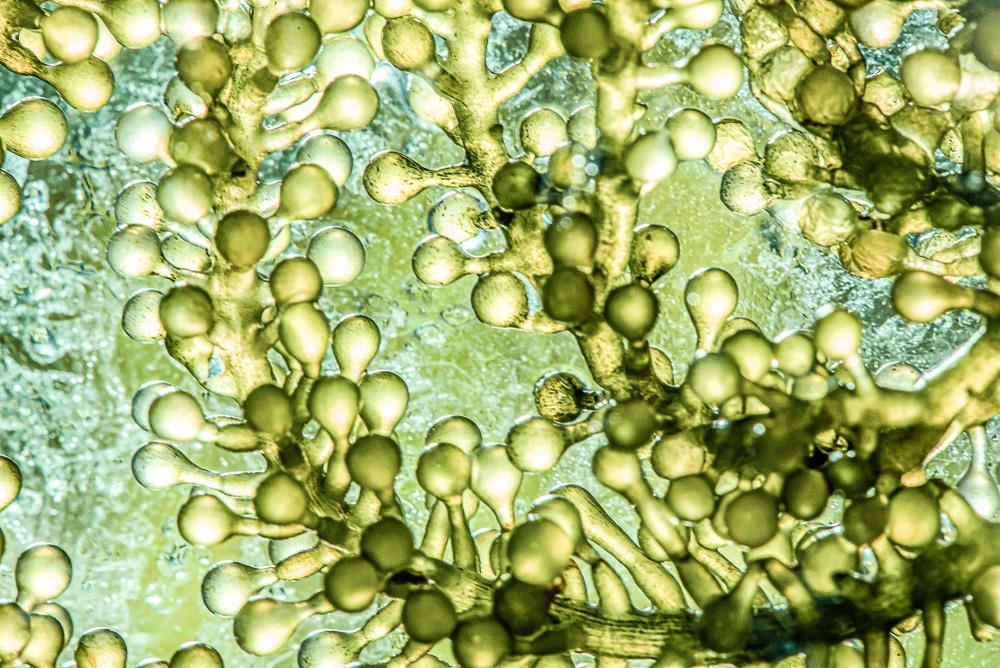Recently, a mini-review was published as a pre-proof in ACS Omega, which provided comprehensive insights into the production of important bioactive compounds via the “algal nanobionics” approach. This study predominantly focused on the role of carbon nanomaterials (CNMs) for efficient algal growth.

Study: Exploring the Role of Carbon-Based Nanomaterials in Microalgae for the Sustainable Production of Bioactive Compounds and Beyond. Image Credit: Chokniti Khongchum/Shutterstock.com
Microalgae: Composition and Function
Microalgae are a vital source for many important value-added biostimulant products; for example, bioactive compounds are widely used in the pharmaceutical industry. Additionally, for many centuries, these have been used as an important food source. Algal species play an important role in the reduction of carbon footprint.
Some of the major components of microalgae are chlorophylls, sterols, hydrocarbons, wax esters, carotenoids, proteins, carbohydrates, phycobilins, minerals, fatty acids, and other bioactive compounds. The concentration of these components varies from one species of microalga to another.
The bioactive compounds extracted from microalgae possess many unique properties, including antimicrobial, anti-inflammatory, antioxidant, and antitumor. These phytoconstituents play an important role in improving human health. Scientists have pointed out some of the advantages of using algal drugs over synthetic drugs. They stated algal drugs are biodegradable, possess superior biocompatibility, and are non-toxic in nature.
One of the essential green microalgae is Chlorella sp., which has been used to produce various value-added components, such as natural lipids, lutein, and β-carotene. The main advantage of this alga is that it is extremely fast-growing and thrives well in environmental stress conditions.
Carbon Nanomaterials and Microalgae
There are many types of CNMs, for example, fullerene, graphene nanosheets, nanocarbon, nanodiamond, graphene oxide (GO), and graphene quantum dots (GQDs). CNMs possess many unique properties, including optical properties, large surface-to-volume ratio, multifunctional surface morphology, immunogenicity, and biocompatibility. Their sizes range from 1 to 100 nm. These nanomaterials are used in many research areas, such as drug delivery.
Among various CNMs, GO has significantly enhanced the bioconversion rate by increasing the catalytic conversion of lipids to biodiesel from wet microalgal (Chlorella pyrenoidosa) biomass. Researchers stated that sulfonated graphene oxide (SGO) exhibits the highest catalytic activity due to a greater concentration of hydrophilic hydroxyl group.
Carbon nanosheets (CNS) are two-dimensional (2D) structures that possess a high surface-to-volume ratio, high chemical stability, light-weighted material and possess superior thermal and electrical properties. CNS can easily pass through the algal pore present in its cell wall, owing to its small size. Subsequently, internalization and distribution of nanoparticles occur throughout its cells and organelles, such as mitochondria, endoplasmic reticulum, chloroplast, and vacuoles. Passive transmission and endocytosis are two methods associated with the internalization of CNS into the algal cells. Passive internalization of CNS into microalgal cells causes minimal damage and has substantially enhanced the bioconversion process.
Recently, enzyme-immobilized nanomaterials have been used for microalgae conversion as it possesses greater recyclability, antibacterial properties, do not require a filtration process, and have better functionality.
The Effect of Carbon Nanomaterials on Microalgae
Nanobionics is an emerging technology that supports the incorporation of CNM into algal cell networks to enhance biosynthetic pathways for the enhanced production of bioactive compounds. For instance, introducing carbon nanotubes (CNTs) through the leaves of a plant boosts the photosynthetic process and enhances the production of secondary carotenoids. However, a similar phenomenon was not observed using single-walled CNTs due to cytotoxic effects.
Several studies have indicated that CNMs can boost the photosynthetic processes within the algal biosystem. These can also modify the physicochemical functions of algae. Hence, microalgae can be used as a sustainable source for producing major value-added biologically active components.
The introduction of CNMs in the algal cell framework augments stress tolerance and the capacity of microalgae to absorb more sunlight, which enhances its photosynthesis process, and results in the increased production of biomass.
Typically, microalgae are cultivated via three different modes, namely, mixotrophic, photoautotrophic, and heterotrophic. As the cost of cultivation and maintenance of microalgae is high, it hampers its widespread development. In this context, scientists reported that the application of CNMs can significantly reduce microalgae's cultivation and maintenance cost.
Researchers have strategized the use of CNS to adsorb algal cells into its surface, promoting rapid cell growth and lipid accumulation. This is an eco-friendly approach to promoting the production of alternative fuels (biofuel). In addition, several microalgae are used as nutraceutical products and the bioactive compounds possess medicinal applications.
Another strategy used to enhance the catalytic activity and biocompatibility of CNMs is the doping technique, which modifies their physicochemical properties. For instance, nitrogen-doped CNS possesses greater photocatalytic activity with higher biocompatibility, which can be determined by the presence of amino and hydroxyl groups.
Future Perspectives
Scientists researching with algal nanobionics have concentrated on improving their understanding of intrinsic metabolic changes at the nano-bio interfaces. This information could effectively enhance the production of bioactive compounds. Additionally, incorporating nanomaterials in the algal system could create novel nano-bio hybrid organisms (algal nano-biohybrids) that can facilitate the superior production of biologically important active compounds. Scientists believe that algal nanobiohybrids could be used to promote sustainability in the medicinal, agricultural, and pharmaceutical sectors.
Reference
Jeevanandham, S. et al. (2022) Exploring the Role of Carbon-Based Nanomaterials in Microalgae for the Sustainable Production of Bioactive Compounds and Beyond. ACS Omega. https://pubs.acs.org/doi/10.1021/acsomega.2c01009
Disclaimer: The views expressed here are those of the author expressed in their private capacity and do not necessarily represent the views of AZoM.com Limited T/A AZoNetwork the owner and operator of this website. This disclaimer forms part of the Terms and conditions of use of this website.